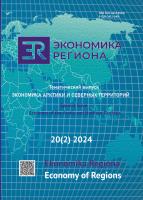Проблемы и подходы к выявлению границ агломераций Севера и Арктики России
Problems and Approaches to Identifying Agglomeration Boundaries in the Russian North and Arctic
Author(s): Sergey A. Kozhevnikov, Svetlana S. Patrakova, Nikolai V. VoroshilovSubject(s): Rural and urban sociology
Published by: Институт экономики Уральского отделения Российской академии наук
Keywords: second-tier agglomerations; Arctic; northern Russia; delimitation of agglomerations; big data; GIS technologies;
Summary/Abstract: Urban agglomerations are currently considered by both scientists and practitioners of public administration. However, the issue of identifying the actual boundaries and creating tools for the development of so-called “second” – and “third-tier” agglomerations, with cores in large and medium-sized cities, remains understudied. Nevertheless, such agglomerations can become development drivers for territories outside the settlement area, primarily in the North and the Arctic. The article aims to determine the composition and boundaries of northern and Arctic agglomerations of Russia considering their specificity. The study presents the authors’ methodological approach to the delimitation of agglomerations combining traditional (isochrones of transport accessibility, gravitational methods) and modern tools (GIS technologies, big data analytics of social networks). As a result, the composition and boundaries of three northern/Arctic agglomerations with cores in Arkhangelsk, Surgut, Norilsk were identified, their specific characteristics were highlighted: the actual borders often do not meet strict traditional criteria of delimitation, particularly, the 1.5-hour isochrone of transport accessibility of the core city due to the weakened effect of geographical proximity; according to the development criterion of the settlement system, two of them (Surgut, Arkhangelsk) can be attributed to agglomerations; despite the underdeveloped settlement framework (the development coefficient is less than 2.7) and a growing share of the core city population in the total population, satellite areas increasingly become economic centres of gravity of agglomerations. The study substantiated the expediency of applying a flexible approach to the delimitation of borders and selecting tools for the development of urban agglomerations, taking into account formation factors and their economic and geographical location, specifically in the North and non-North projections. Further research will involve an in-depth assessment of localisation and urbanisation effects of the studied agglomerations.
Journal: Экономика региона
- Issue Year: 20/2024
- Issue No: 2
- Page Range: 429-445
- Page Count: 17
- Language: Russian

